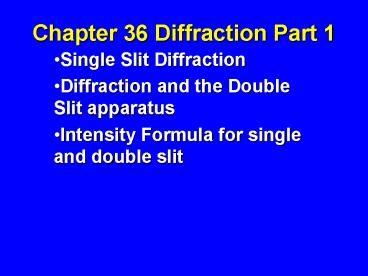Chapter 36 Diffraction Part 1 - PowerPoint PPT Presentation
1 / 26
Title:
Chapter 36 Diffraction Part 1
Description:
Chapter 36 Diffraction Part 1 Single Slit Diffraction Diffraction and the Double Slit apparatus Intensity Formula for single and double slit Definition and Types of ... – PowerPoint PPT presentation
Number of Views:162
Avg rating:3.0/5.0
Title: Chapter 36 Diffraction Part 1
1
Chapter 36 Diffraction Part 1
- Single Slit Diffraction
- Diffraction and the Double Slit apparatus
- Intensity Formula for single and double slit
2
Definition and Types of Diffraction
- Diffraction is the bending of a wave around an
object accompanied by an interference pattern - Fresnel Diffraction - curved (spherical) wave
front is diffracted - Frauenhofer Diffraction - plane wave is diffracted
3
Examples of Fresnel Diffraction
Fresnel Diffraction from a sharp edge
Fresnel Diffraction from a circular obstruction
Fresnel bright spot
4
Example of Frauenhofer (plane wave) Diffraction
5
Diffraction Minima
Flaring of rays greater when silt size is smaller
and small compared to the wavelength of light ?
What is the anlge of the first minima when
6
Single Slit Diffraction - Minima
- Slit has width a
- Divide slit into 5 wavelet sources see text
for a different number of slit divisions - If the path difference is half a wavelength for
any pair, they will cancel - Minimum occurs if all pairs cancel i.e. 1 and 3
and 5 plus 2 and 4
Dividing the slit in 4 yields
Dividing the slit in 6 yields
7
Single Slit Diffraction - Minima
8
Phase Construction which allows us to derive the
Intensity at Point P on Screen
9
Phase Difference between adjacent points in slit
10
Single Slit Diffraction - Intensity Distribution
- Consider next adding the amplitudes of the
electric field vector, including phase for each
increment - The resulting electric field is the vector sum as
shown in the figure - Now let N go to infinity
11
Single Slit Diffraction - Intensity Distribution
- Divide the slit into small increments Dy
- Determine the phase difference Db
The total phase difference for N increments is
12
Single Slit Diffraction - Intensity Distribution
(2)
- Combine and square since intensity is
proportional to the square of the electric field
13
Single Slit Diffraction - Intensity Distribution
- Minima occur when f mp, except
- when f 0 a maximum occurs
- Other maxima occur at solutions of intensity
equation for sin q 1
14
Double Slit and Diffraction
15
Recall Intensity by Phasor Method for Double Slit
16
Single Slit Diffraction - Envelope for other
interference patterns
Intensity equation for a double slit
17
For Exam Study such problems
- Example 36-5
18
Resolution Diffraction and Rayleigh Criteria
19
Sample Prob. 36-4
- What is distance between peaks on screen?
20
Diffraction Grating
- Generalize the double slit in addition to
diffraction from each slit - For adjacent slits
21
Gratings Instensity
- Intensity plot as a function of angle
22
Width of lines and the first minima
- Angle (and thus distance to ) first min from the
central max
23
Distance to the first Minimum
- As in the single slit diffraction pattern, the
first minimum occurs when the path length
difference betwn the top and bottom rays equals - Half-width of any other line depends on location
relative to central axis is,
24
Grating Spectrometer
- S-source, L1-Lens, S1-slit, C-collimator,
L2-Lens, G-grating - Light from source focused by L1 on vertical slit
S1 placed in focal plane of L2. Emerging light
is a plane wave incident on G-grating diffracted
into diffraction patter, with m0 order
diffracted at angle along central axis
of the grating - Lens L3 of telescope focuses light diffracted at
angle onto focal plane FF within
telescope
25
X-ray Diffraction
- Standard optical diff. grating cannot be used to
discriminate btwn different wavelengths in the
x-ray wavelength range ie d3000nm shows that
first max - If could resolve.
- 1912 Max von Laue, crystal lattice forms a
natural diffraction gratting for x-rays.Nobel
Prize
26
Geometry of X-ray diffraction
Braggs Law 1915
X-ray diffraction powerful tool for studying
x-ray spectra and the arrangement of atoms in
crystals. Spectra a set of crystal planes
having known spacing, d, are chosen. They
reflect different wavelengths at different
angles. A detector that can discriminate one
angle from another can be used to determine the
wavelength l of radiation reaching it. The
crystal itself can be studied with a
monochromatic x-ray beam, to determine not only
the spacing btwn various crystal planes but also
the structure of the unit cell.































